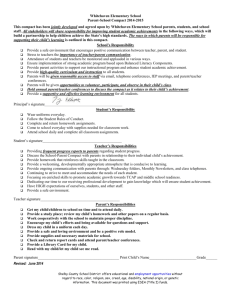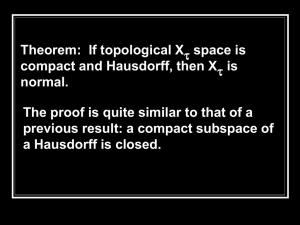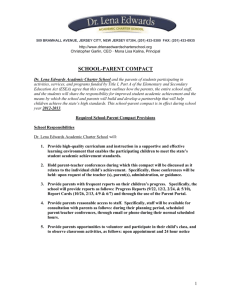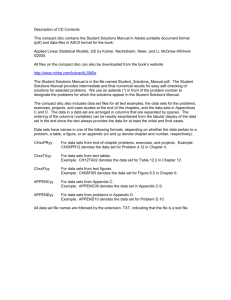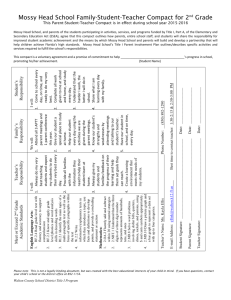Project_2_Problem_3
advertisement
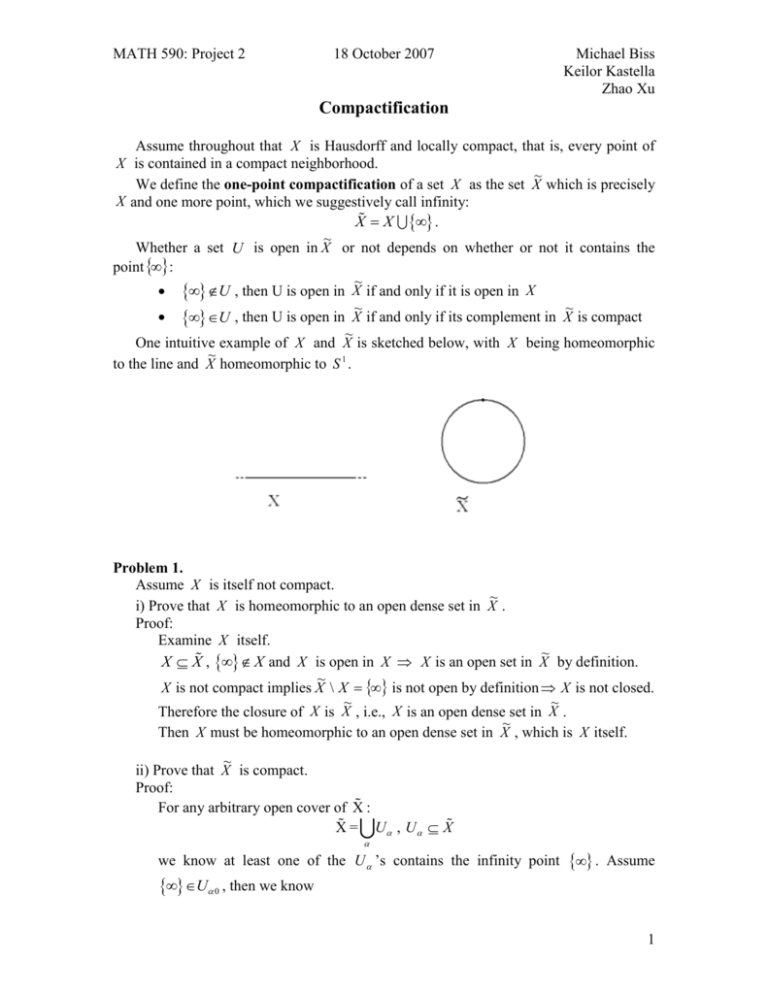
MATH 590: Project 2 18 October 2007 Michael Biss Keilor Kastella Zhao Xu Compactification Assume throughout that X is Hausdorff and locally compact, that is, every point of X is contained in a compact neighborhood. ~ We define the one-point compactification of a set X as the set X which is precisely X and one more point, which we suggestively call infinity: X X . ~ Whether a set U is open in X or not depends on whether or not it contains the point : ~ U , then U is open in X if and only if it is open in X ~ ~ U , then U is open in X if and only if its complement in X is compact ~ One intuitive example of X and X is sketched below, with X being homeomorphic ~ to the line and X homeomorphic to S 1 . Problem 1. Assume X is itself not compact. ~ i) Prove that X is homeomorphic to an open dense set in X . Proof: Examine X itself. ~ X X , X and X is open in X X is an open set in X by definition. ~ X is not compact implies X \ X is not open by definition X is not closed. ~ ~ Therefore the closure of X is X , i.e., X is an open dense set in X . ~ Then X must be homeomorphic to an open dense set in X , which is X itself. ~ ii) Prove that X is compact. Proof: For any arbitrary open cover of X : X = U , U X we know at least one of the U ’s contains the infinity point . Assume U 0 , then we know 1 MATH 590: Project 2 18 October 2007 X\U 0 and that X\U 0 . 0 0 Michael Biss Keilor Kastella Zhao Xu U U is therefore an arbitrary open cover of the set X\U 0 . Since U 0 is an open set that contains , we know X\U 0 is compact, which means any open cover of this set must have a finite subcover corresponding to it. Therefore, we can find a finite subcover of X\U 0 generated by U , 0 denoted as X\U 0 FINITE 0 U . Now we obtain FINITE X U U 0 0 which shows that an arbitrary open cover of X , denoted as 0 U , generates a FINITE finite subcover of the set expressed by U U 0 . Therefore by definition, 0 X must be compact. iii) Prove that X is connected Proof: For the simplest case, assume X is itself connected Let X = A B , A X , B X , A and B are disjoint and both open. We know the infinity point must be contained in one of the sets A and B. Without loss of generality, we assume A and B . By definition of the topology, we know B is open in X B is open in X A is open in X X \ A X is compact. Plus X is Hausdorff, we know X \ A X must be closed X \ X \ A A \ is open in X Hence we get X= A \ B , A \ X , B X , A \ and B are disjoint and both open. X is connected requires that the only way to make this statement true is to have A \ =X and B= A= X and B= Therefore, X must be connected. Careful, as it is it might be that A minus infinity is empty and B is X. This can happen if infinity is by itself an open set, which is the case when X is compact to begin with. The more generalized case would be when X is not connected. In such cases we consider the intersection of set A and B (as defined above) with each of X’s 2 MATH 590: Project 2 18 October 2007 Michael Biss Keilor Kastella Zhao Xu connected components. Consider, for example, one of the connected component of X, denoted as Ci . From the above approach, we already know that: X= A \ B , A \ X , B X , A \ and B are disjoint and both open. (Note this result has nothing to do with the connectedness of X, hence is always true) An equivalent way of expressing such a statement is that: X= A \ B , A \ X , B X , A \ and B are disjoint and both closed. Ci is a connected component of X, hence is closed. Then we obtain the following result, from the fact that the intersection of closed sets is still closed: Ci = A \ Ci B Ci , A \ Ci Ci , B Ci Ci , A \ Ci and B Ci are disjoint and both closed. Ci is itself connected, so the only way to make the above statement to be true is to have A \ Ci = Ci and B Ci = Take the union for all the connected components, we then have: A \ Ci A \ Ci A \ X i i Ci B X B Ci B i i i Ci X i A \ =X and B= , hence A= X and B= Therefore in this case X is also connected. In all, we have proved that X is connected. iv) Prove that X is Hausdorff Proof: Take arbitrarily any two points a and b in X . We divide the problem into two cases Case I: if both the two points are not the infinity point, then a X and b X . X is itself Hausdorff, hence by definition there would always exist two disjoint open sets A X and B X such that a A and b B Case II: if one of the two points, say, a , is the infinity point. We know X is locally compact, which means there would always be a compact neighborhood BCOMP X of which b is an internal point. Certainly we can find an open set B ' BCOMP that contains b . At the same time, from the definition of the topology, we know X \ BCOMP is an open set since X \ BCOMP . This way we also find two disjoint open sets in X , namely B ' and X \ BCOMP , that separates the two points a and b apart. 3 MATH 590: Project 2 18 October 2007 Michael Biss Keilor Kastella Zhao Xu Combine those two cases, we show that any two points in X can be separated by two disjoint open sets. Therefore X must be Hausdorff. Problem 2. Show that if X and Y are homeomorphic, so are their one-point compactifications. ~ ~ ~ Let f be a homeomorphism between X and Y . Define a function f : X Y in the following way: ~ f x x X \ X ~ f x . In the second line here you want x= infinity ~ x X \ X We claim that this is a homeomorphism. It is clearly bijective. We show that it is ~ ~ continuous. Let U be open in Y . Examine f 1 U , which is well defined as our constructed function is a bijection: ~ 1 ~ U , then f U f 1 U is open in X as X and Y are homeomorphic ~ ~ ~ U , then f 1 Y \ U is compact because f is continuous and f 1 U and ~ 1 ~ ~ ~ f Y \ U are a partition of X as each point in Y has only one preimage. ~ ~ Therefore f 1 U is open in X as its complement is compact. Note that the converse is not true. For instance, let X 0,2 and let Y 0,1 1,2 . ~ ~ Then X Y 0,2, but X and Y are not homeomorphic because the former is connected whereas the latter is disconnected. Problem 3. Show that the one-point compactification of the plane (with Euclidean topology) is homeomorphic to the sphere. From problem 2 we know that if two spaces, X and Y, are homeomorphic, so are their one-point compactifications. 2 In Project 1, we have already shown that the plane is homeomorphic to a sphere 3 minus a single point in with Euclidean topology, denoted here using our convention S \ S \ in this problem as . The one-point compactification of should be the whole sphere S, since S is closed and bounded, hence is compact. So from the result of 2 Problem 2 in this project, we know the one-point compactification of the plane must be homeomorphic to the sphere. Problem 4. Find the one-point compactification of different sets X To find the 1-point compactification of X, we have several different approaches. One way comes directly from the definition of the one-point compactification. We have to show that with the point added in, the resulting set X must be compatible with the 4 MATH 590: Project 2 18 October 2007 Michael Biss Keilor Kastella Zhao Xu topology we defined in the problem, i.e., any open set containing in X must have its complement to be compact. The other way, however, is to use the result of Problem 1 in this project, which states that the 1-point compactification of a set X is the set X which has exactly one more point than X and is compact. There is a third way of solving this problem in some specific cases, which is to use the result of Problem 2 in this project to build a homeomorphism from the one-point compactification of the set under investigation to that of some set we are already familiar with. a) An open disc in the plane: In this specific problem, we want any open set that contains the point must at the same time contain a thin open strip around the edge of the open disc, which guarantees its complement is closed, bounded and therefore compact (in the Euclidean topology). Geometrically, the way to achieve that is to bring the edges of the disc up to meet the point at infinity, which results in a sphere. 2 In fact we know from the last project that an open disc in is homeomorphic to 2 2 itself. Problem 3 shows that the one-point compactification of is the sphere, then so will be the one-point compactification of the open disc. b) A closed disc in the plane minus a point. In this specific problem, we set X to be the whole closed disc. In this way, any open set that contains the point , which is the missing point, must at the same time contain a small open disc around , which guarantees its complement is closed, bounded and therefore compact (in the Euclidean topology). Geometrically, ”fills in” the hole left by the missing point in the disc, which results in a closed and bounded disc X that is compact in Euclidean topology. 5 MATH 590: Project 2 18 October 2007 Michael Biss Keilor Kastella Zhao Xu c) An open interval of the real line. In this specific problem, we want any open set that contains the point must at the same time contain some fluff around both point a and point b, which guarantees its complement is closed, bounded and therefore compact (in the Euclidean topology). Geometrically, the way to achieve that is to attach the “ends” of the open interval together at the point, , which results in a circle X that is compact. . d) A bunch of open intervals of the real line Without loss of generality, consider a bunch of open intervals (a, b), (c, d), (e, f), (g, h). In this specific problem, we want any open set that contains the point must at the same time contain some fluff around every point (a, b, c, d, e, f, g, h), which guarantees its complement is closed, bounded and therefore compact (in the Euclidean topology). This technique will work for any number of open intervals, and geometrically, the way to achieve that is shown below, i.e., for n open intervals, we get a “clover” of n circles. It is obvious that the “clover” X is compact 6
